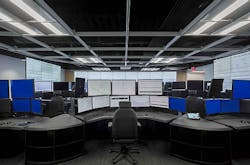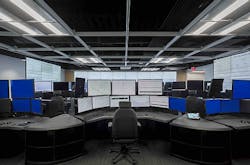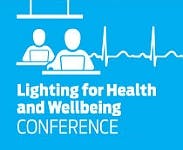Circadian Light’s luminaires switch from a blue pump to a violet one at night, for health reasons.
With LED illumination in some quarters slowly gaining a health-related reputation up there with sugar and tobacco, one lighting company has gained UL certification to help distinguish its office lights for avoiding potentially deleterious frequencies.
Interested in articles & announcements on human-centric lighting?
Stoneham, MA-based Circadian Light, which has participated in the past Lighting for Health and Wellbeing Conference, said UL has verified that the white light emitted by its NightSafe LED chip contains less than 2% blue content at night. Circadian uses the chip inside troffers and lights for office lighting, such as a troffer it calls the DynamicBlu. The Plessey-made chip itself is not new, but the UL certification is, and Circadian pointed out that it’s the first time UL has weighed in on blue levels.
Blue frequencies — the 440–490-nm range in Circadian’s book — have been linked to an increased risk of breast and prostate cancer, diabetes, cardiovascular diseases, and other maladies when used at nighttime. While in daytime hours they provide a desirable stimulating effect, at night they disrupt the body’s circadian rhythm and can thus confuse different biological systems.
White light contains a wide range of frequencies. There is no one single combination required to equal white light, although white-light LEDs typically contain a stable of blue frequencies. Circadian’s NightSafe chip uses a violet pump rather than a blue one, a company spokesperson told LEDs Magazine. A control board in Circadian’s luminaires detects the onset of nighttime, and the luminaire then draws on the violet chip rather than on a separate chip-based blue pump that the luminaire uses during the day, the spokesperson said. Violet has a shorter wavelength than blue, starting at around 380 nm, and is not believed to have the same health implications. Circadian’s Plessey violet chip peaks at 415–420 nm.
Controlling the blues: This control room at a Circadian Light customer site represents a human-centric lighting design that minimizes potentially harmful blue frequencies at night by switching from the blue pumps to the violet ones inside the ceiling luminaires. (Photo credit: Circadian Light.)
“This medically-significant breakthrough addresses the growing scientific evidence that exposure at night to the 10–30% blue light content of conventional LEDs has a profound negative effect on many aspects of human health and performance,” Circadian said.
Some lighting vendors maintain that blue light’s harmful effects can be mitigated by simply warming up a light’s color temperature (CCT) to the 2700K level associated with orange and amber light.
But as LEDs Magazine wrote in a recent feature on human-centric lighting, Circadian and other lighting experts have pointed out that such warm-CCT light can still contain a damaging amount of blue frequency. With its announcement of UL certification, Circadian repeated the notion that spectral power distribution — the amount of different frequencies — is more important than the CCT when it comes to health consequences.
“Color tuning down to 2700K still emits 8–10% harmful blue content, with 500% more blue light than Circadian’s NightSafe LED technology,” said Doros Platika, Circadian executive chairman. “Circadian lights are thus the only UL verified white light solution that meets the health target of emitting less than 2% blue.”
A Circadian spokesperson added that “research shows that more than 2% in blue in a well-lit room at night can disrupt circadian rhythms and suppress melatonin and causes health risks.” Melatonin is a hormone associated with sleep.
The same intelligent control board that prompts the troffer to switch from the blue LED to the violet LED also continually adjust lighting levels — including hues, frequencies, and brightness — throughout the day and night, regardless of which chip is in action. The board includes an astronomic clock.
“Our goal is to create lights that combine the longevity and energy efficiency of LEDs with the ideal spectrum of light by time of day, season, and geographical location to entrain circadian rhythms and optimize human health and performance,” said Circadian CEO Martin Moore-Ede. “These lights boost alertness and productivity whenever you need it, without the circadian disruption caused by the high nocturnal sensitivity of circadian rhythms to blue light after sunset.”
Circadian said products that use the low-blue technology are in use at large companies, but it declined to identify them.
The UL certification is the latest recognition of a link between modern LED lighting and human health. The science of human-centric lighting, also known as circadian lighting or lighting for health and wellbeing, is still very much in its early days. While many scientists believe that there is a link, not all experts agree on the specific causes and effects.
For example, the American Medical Association has recommended that when municipalities install new streetlights, they should use 3000K or warmer. But that strict CCT perspective clashes with the spectral power perspective that others advocate.
Rensselaer Polytechnic Institute’s Lighting Research Center (LRC) earlier this year said a small study revealed that it wasn’t blue light per se from Apple iPads that was disturbing users’ sleep at night. Rather, other factors associated with late night iPad use were the culprit — factors such as screen brightness as well as the general stimulation of usage.
The finding was a surprise because blue light from gadgets at night has gained a reputation for being a particular culprit in sleep disturbance.
The discussions and debates will not be going to bed anytime soon. LEDs Magazine will continue to update you.
Check out these other stories on the health effects of LED lighting and updates on industry activity:
LRC’s Mark Rea will lead UL circadian lighting task group
Blue-free white light breaks the paradigm of circadian lighting
Circadian scientists who have studied light's impact win Nobel
Multi-channel SSL system enhances health and wellbeing in residential retrofit - Part 1







